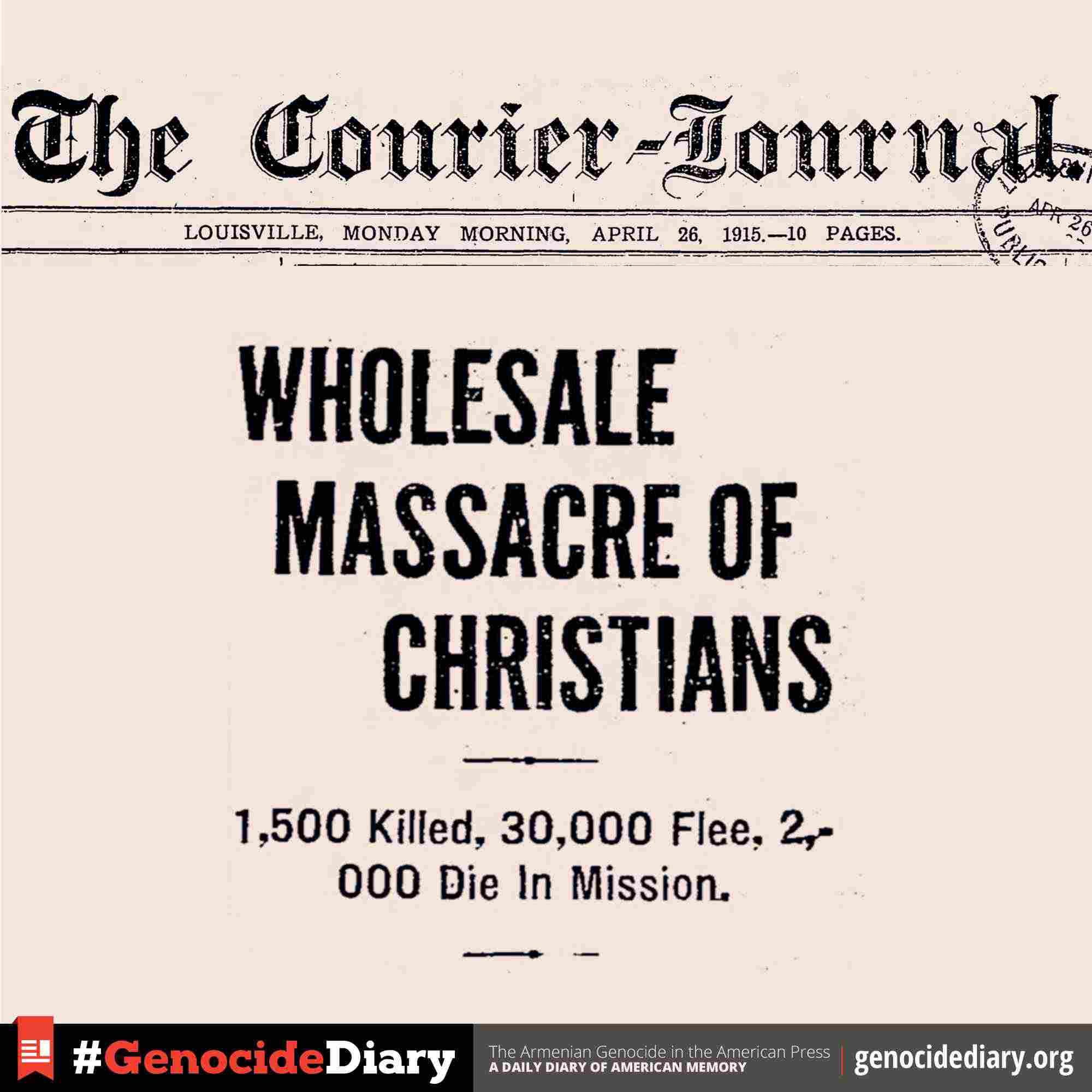Wholesale Massacre of Christians. 1,500 Killed, 30,000 Flee, 2,000 Die in Mission. Inhabitants of Ten Villages Put to Death. Mothers Throw Their Children Into Rivers.
- DATE 26 Apr , 1915
- POSTED IN Kentucky, United States
Dilman, Persia, April 24 (via Petrograd to London, April 26, 3:10a.m.),-
The exodus of from 20,000 to 30,000 Armenians and Nestorian Christians from Azerbaijan province, the massacre of over 1,500 of those who were unable to flee, the death from disease of 2,000 in the compounds of the American mission in Urumiah and possibly of an equal number of refugees in the Caucasus have been confirmed.
When it became known the night of January 1-2 that the Russian forces had left Urumiah about 10,000 Christians fled, most of them without money, bedding or provisions.
A majority of the people started out afoot through mud knee deep, across the mountain passes in freezing weather. At Dilman they were joined by many more for Salmas Plain. But for Father de Cross, of the Roman Catholic mission at Hosrova, near here, the disaster might have become historic. After assuring the safety of the sisters of the mission. Father de Cross joined the pilgrims and managed to secure bread and shelter for many of them. The caravansaries were so crowded that thousands slept in the mud and the snow. Children were born on the roadside or in the corner of a caravansary.
Threw Children in River
Arriving at Julfa, on the Russian border, passport difficulties added to the troubles of the fleeing people. Maddened women threw their children into the Araxes River or into pools in order to end their sufferings from cold and hunger.
Father de Cross had to put his back against a wall to fight off the famished mob when he began distributing bread. The mud and cold and the shelterless nights, during which the garments of the refugees were frozen knee high, continued for three weeks, until the people were slowly dispersed by rail.
All Inhabitants of Ten Villages Killed
Wholesale Massacres of Armenians and Christians by Mohammedans Confirmed
Tiflis, Trans-Caucasia, April 24 (via Petrograd and London, April 25, 4:15p.m.)-
Refugees who have reached the Russian line report that the massacre of Armenians by Mohammedans is being continued on even a greater scale. They say that all the inhabitants of ten villages near Van, in Armenia, Asiatic Turkey, have been put to death. On being advised of massacres at Erzerum, Borjan and Zoltus and of the conditions at Van, the Katolikos, head of the Armenian Church at Etchmiadzin, near Erivan, cabled to President Wilson an appeal to the people of the United States on behalf of the Armenians.
Massacre at Urza
Robert M. Labaree, an American missionary of Urumiah, Persia, who visited the Erivan villages and with whom the refugees were quartered, says he found the humanity of the people as broad as their means were limited. The village governments or relief committees had issued eight pounds of flour to each refugee in six weeks.
The Associated Press received reports of the massacre of 800 of the villagers in Urza and of 720 in Salmas.
The painful uncertainty concerning the 15,000 survivors of Urza was confirmed by a journey through Salmas. Three weeks had failed to obliterate the signs of the slaughter. Pools of blood still marked the execution places in Haftevan. The caps of thirty-six victims lay where a mud wall had been toppled over on them.
A young man named Hackatur related the story of his escape from a well in which the bodies of the dead had been crammed. He fell with others and was tossed into the well, but he managed to wriggle through the bodies lying on top of him and escaped at nightfall.
Not all the Christians lacked the courage or means for self-defense. At the desolated Catholic mission at Hosrova, where forty-eight victims of the massacre were buried. Elizabeth Marcara, an Armenian girl, told how she and young David Ishmu battled with the Kurds. Her story later was amply confirmed.
‘When the Kurds burst the village gates,
said Miss Marcara, ‘we took rifles and mounted to the roof. I fired eighty shots. The Kurds were forced to withdraw outside the village wall.
‘There I killed two and David two. Later we killed four more, one of whome was the chief. The Kurds abandoned their plunder and carried off their dead.
‘The battle lasted three hours. The death of their chief caused the Kurds to flee. We came from the roof and recovered the things the Kurds had left behind them.
‘Re-enforced, I fled with my relatives. We saw the Kurds engaged in the pillage of Hafgvan and fired on them, but they escaped with their booty.
‘Near Dilman we were attacked by fifteen Kurds, of whom I killed on. After the Russians defeated the Kurds and Turks, near Khol, a soldier told the Persian Government about me and he sent for me and offered me the chieftainship of a regiment of Turks if I would fight the Russians.


